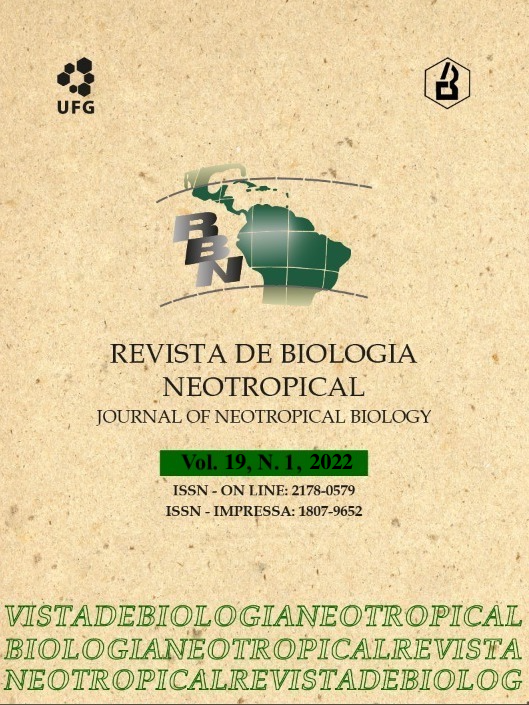First record of nests built using domestic dog hair by Todirostrum maculatum (Desmarest, 1806) (Aves: Passeriformes) in central Amazonia
Keywords:
breeding biology, natural history, nests descriptionAbstract
The use of mammalian hair as a nest-building material by Amazonian birds is poorly documented. Here, we describe the use of the hair of a domestic dog as nest-building material by the Spotted Tody-Flycatcher, Todirostrum maculatum. The nesting pair collected the dog hair from the ground to construct their nest. The use of this material appeared to be highly opportunistic.
Downloads
References
Batisteli, A. F., R. Guilhermo-Ferreira & H. Sarmento. 2019. Abundance and prevalence of plastic twine in nests of Neotropical farmland birds. Wil. J. Ornith. 131:201-205. DOI: https://doi.org/10.1676/18-24
Crozariol, M. A., M. G. J. Carvalho, A. S. Paula & W. R. Telino-Júnior. 2016. Primeira descrição do ninho de Poecilotriccus plumbeiceps cinereipectus proveniente de Pernambuco, Brasil e alguns comentários sobre o período reprodutivo da espécie. Atual. Ornitol. 193: 10-13.
Di Giacomo, A. G. & B. L. Lanús. 1998. Aportes sobre la nidificacion de veinte especies de aves del noroeste argentino. El Hornero. 15: 29-38.
Ferreira, D. F., M. M. de Aquino, N. M. Heming, M. Â. Marini, F. Sá F. Leite & L. E. Lopes. 2019. Breeding in the gray-headed tody-flycatcher (Aves: Tyrannidae) with comments on geographical variation in reproductive traits within the genus Todirostrum, J. Nat. Hist. 53: 595-610. DOI: https://doi.org/10.1080/00222933.2019.1599458
Floriano, D. D., J. Lima, & E. Guilherme. 2020. Breeding biology of the Olivaceous Flatbill (Rhynchocyclus olivaceus) in an Amazonian forest fragment of northwest Brazil. Wil. J. Ornith. 132: 587-597. DOI: https://doi.org/10.1676/19-102
Freile, J. L. 2015. Nesting of the Scrub tanager (Tangara vitriolina) in Andean Ecuador. Ornit. Neotrop. 26: 51-58.
Greeney, H. F., R. A. Gelis & R. White. 2004. Notes on breeding birds from an Ecuadorian lowland forest. Bull. Brit. Ornithol. Club. 124:28-37. DOI: https://www.biodiversitylibrary.org/part/76544
Haverschmidt, F. 1955. Notes on the life history of Todirostrum maculatum in Surinam. The Auk. 72: 325-331. DOI: https://doi.org/10.2307/4081444
Hilty, S. L. & W. L. Brown. 1986. A Guide To The Birds of Colombia. New Jersey, Princeton University Press.
Ingels, J., M. Clément, M. Fernandez, G. Gazel, V. Pelletier, Rufray, V. & O. Claessens. 2016. Nesting of Smoky-fronted Tody-Flycatcher Poecilotriccus fumifrons in French Guiana. Bull. Brit. Ornithol. Club. 136: 46-52. DOI: https://www.biodiversitylibrary.org/item/252798
Jagiello, Z., Ł. Dylewski, M. Tobolka & J. I. Aguirre. 2019. Life in a polluted world: A global review of anthropogenic materials in bird nests. Environ. Pollut. 251: 717-722. DOI: 10.1016/j.envpol.2019.05.028.
Marceliano, M. L. V. 1982. Notas sobre o comportamento reprodutivo de Todirostrum maculatum (Desmarest, 1806). Bol. Mus. Para. Emílio Goeldi Nova Ser. Zool. 15: 1-21. DOI: http://repositorio.museu-goeldi.br/handle/mgoeldi/472
Melo, T. N. & H. F. Greeney. 2019. Notes on the breeding biology of birds in riverine floodplains of western Amazonia. Bull. Brit. Ornithol. Club. 139: 56-64. DOI: https://doi.org/10.25226/bboc.v139i1.2019.a4
Rodríguez-Ferraro, A & A. B. Azpiroz. 2006. Notes on the breeding biology of Maracaibo Tody-flycatcher Todirostrum viridanum. Cotinga. 25: 18-20.
Walther, B. A. 2004. Genus Todirostrum, species accounts. pp. 332-335. In: del Hoyo, J., A. Elliott & D. A. Christie (Eds.). Handbook of the birds of the world Vols 9. Barcelona, Lynx Edicions.
Downloads
Published
How to Cite
Issue
Section
License
Copyright (c) 2022 Revista de Biologia Neotropical / Journal of Neotropical Biology

This work is licensed under a Creative Commons Attribution-NonCommercial 4.0 International License.
The expontaneos submmition of the manuscript automaticaly implies in the cession of all patrimonial rights for the Journal of Neotropical Bilogy (RBN) after publication. The autor allow the right of first publication of the article to the RBN, under Creative Commons Attribution 4.0 (CC BY-NC 4.0) Licence.
There are garanties for the authors to the authorial and moral rights, for each one of the articles published by RBN, with permissions:
1. The use of article and contents for the education and researches.
2. The use of the article and their contents, linking to the Article on the web site of the RBN, allowing the divulgation on:
- institutional closed web (intranet).
- open access repositories.
3. Preparation and divulgation of the other publication derived from the article and its content, if there is citation of the original publication by RBN.
4. Make printed copies in small quatinties for personal use.

















